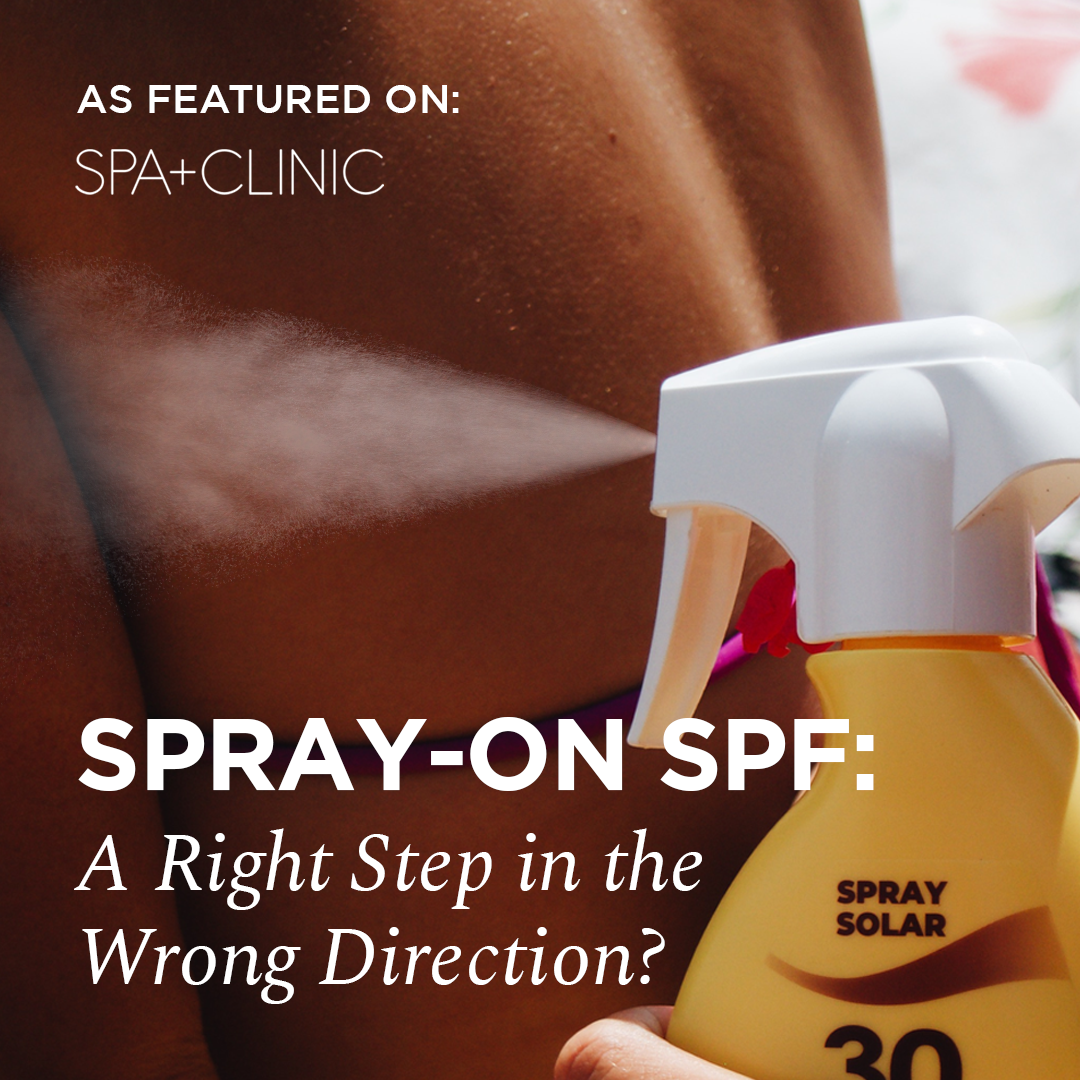
This article was originally published on SPA+CLINIC.
SPA+CLINIC catches up with leading Dermatologist Dr Natasha Cook for her take on spray-on sunscreens.
When it comes to sunscreen, there are many emerging products wanting to claim the title for most innovative, and as many clients are put-off from using certain SPF products due to the thick consistency and heavy texture on the skin, it’s great to see lighter consistencies on the market. But there’s also a common issue of clients not re-applying their sunscreen as per the recommended re-application timeframes, commonly due to already having applied makeup over the top of their sunscreen.
To combat this, companies have now created sunscreens in the form of aerosol sprays, which claim to aid in re-application without disrupting makeup, or just to provide ease in re-applying. Seems innovative, right?
Sunscreens, especially within Australia, are classed as therapeutic goods according to the Therapeutic Goods Association (TGA). This means the registration and manufacturing processes for new products, guidelines for use, and advertising are very different to standard skincare. However, this does not impact or ensure that the product is as effective as it may claim, if not used as advised.
It begs the question – are spray-on sunscreens enough when it comes to protection?
We caught up with leading Dermatologist Dr. Natasha Cook for her take on spray-on SPFs, along with some general advice on sunscreens.
Why is spray-on SPF not effective in protecting against UV damage?
When it comes to UVA/UVB protection with SPF and sunscreen – application is everything.
It’s what we refer to as an exponential dose delivery curve. So, if you under-apply by half, you are getting less than a quarter of the SPF labelled on the jar.
We know for a fact that 80 percent of consumers under apply by half! Throw in a spray on application that is aerosolised, and you have a disaster for your skin getting practically no protection and simply burnt… or what I like to term “skin cancer suicide”.
Aerosolised spray on products are tested in their pure liquid form before they are put into an aerosolised format. So the testing is not reflective of the spray on final product, which is significantly diluted from the original liquid form that “gains” its SPF rating.
You would have to meticulously spray multiple layers to achieve the SPF that is advertised on the can.
Then, add in the issues of technique. Spray-on application lends itself to human error. Easy to miss the target (your skin), along with environmental factors (such as the wind) leads to inconsistencies with the application. Whether it is aerosolised or non-aerosolised – there is pretty much the same issue.
Creams and lotions format wins every time! You can see the application, plus, it goes on in a consistent controlled layer.
If re-applying is the issue of getting patients to comply to regular SPF application, what is a more effective alternative to re-applying if not a spray-on SPF?
To be honest there are some great CC SPF products that can be applied layer upon layer and not ball or pill up. Simply reapply your blush and lip and off you go. The spray-on products are honestly delivering a false sense of security, as do loose-powder mineral SPFs.
You simply are not getting the coverage and appropriate distribution of the UVA/UVB protecting ingredients. If you are outdoors swimming, sporting etc, then reapplying a lotion cream SPF is really not a big deal. Add a CC cream with SPF over the top for extra protection and skin perfection!
Are chemical SPF and physical-based SPFs that much different in their protection?
Not all sunscreens and SPF products are created equally. However, the Australian standards and testing are probably the best in the world – so another reason to buy Australian made when it comes to SPF.
Different ingredients have different spectrums of UV and visible light that they “block” or protect from. For example, Zinc is a great UVA blocker, whereas Titanium dioxide is a great UVB blocker. So ideally you want to have a product that has both.
It’s similar for chemical SPF ingredients. Different ones are better at protecting against different UV wavelengths, so, you need a combination.
I personally love physical blockers as they are natural minerals that have no allergenic potential. However, they are harder to formulate and can be more expensive and whitening if you are going for high SPF. Therefore, for sport sunscreen products I recommend finding one that has at least one physical blocker with the chemical blockers in combination.
For everyday, I wear my dr.NC Concentrated CC+ Cream SPF 30 that is mineral only and has 5% niacinamide, which gives me both anti-oxidant and environmental protection. I love that it’s tinted, as we now know that iron oxides give you protection from visible light. Just another element we need to be worried about when it comes to skin ageing and damage!


























